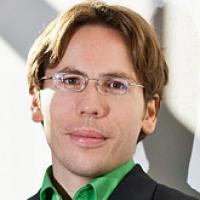SystemX Affiliates: login to view related content.

At the nanoscale, carbon nanotubes (CNTs) have higher carrier mobility and carrier velocity than most incumbent semiconductors (including silicon). Thus CNT based field-effect transistors (FETs) are being considered as strong candidates for replacing CMOS in future digital circuits. The predicted high intrinsic transit frequency has also inspired investigations on analog high-frequency (HF) applications. More recently, it has been realized that CNTFETs may also possess a highly linear transfer characteristic, which is extremely valuable for a more energy efficient usage of the frequency spectrum, particularly in mobile communications. The relaxed technology contraints compared to digital applications, make an entry in the low GHz HF market more probable and feasible than large-scale digital circuit. For medical applications and wearable electronics CNT-based thinfilm transistors have a huge potential due to intrinsically stretchability and high apparent mobility compared to other materials.
This talk presents the state-of-the-art of HF CNTFET technology from an engineering point of view and discusses the incredients needed for enabling CNTFET-based HF applications. The status of the employed multi-scale simulation tools covering physical effects in detail at the atomistic level up to compact models for CNTFET circuit design and simulation will be discussed, along with practical examples for their application, such as the exploration of process and material options for optimizing the transistor toward high device linearity. Furthermore, selected examples for experimental results for important DC and HF characteristics of fabricated devices will be shown. These results also demonstrate the accuracy of a newly developed CNTFET compact model for the design of analog HF circuits. The presentation will conclude with an outlook on the compact modeling of CNT-based thinfilm transistors and related circuit design.
Martin Claus received his Dipl.-Ing. and Dr.-Ing. degree in electrical engineering in 2004 and 2011 from the Technische Universität Dresden (Germany). During his doctoral research, he investigated CNTFETs with emphasis on modeling and simulation. His research interests include compact modeling and application-oriented evaluation of novel transistor technologies using numerical device simulations, physical analysis, electrical device characterization and benchmark circuit design.
Since the beginning of 2013 he has been an independent research group leader of the device-modeling group for emerging electronics at the German cluster of excellence “Center for Advancing Electronics Dresden” (Cfaed), Technische Universtität Dresden. Martin Claus has been heading an interdisciplinary and international group with researchers from the departments of electrical engineering, chemistry and physics. Together with his group, he aligns, supports and inspires the technology development of analog high-frequency CNTFETs towards the needs of the circuit designer. The nucleus of his research is an experimentally verified multi-scale simulation framework developed in the group, connecting benchmark circuit design and compact model development with TCAD and atomistic simulations. During his current research stay at the Stanford University, he has developed a compact model and a related simulation infrastructure for CNT-based thinfilm transistors.


